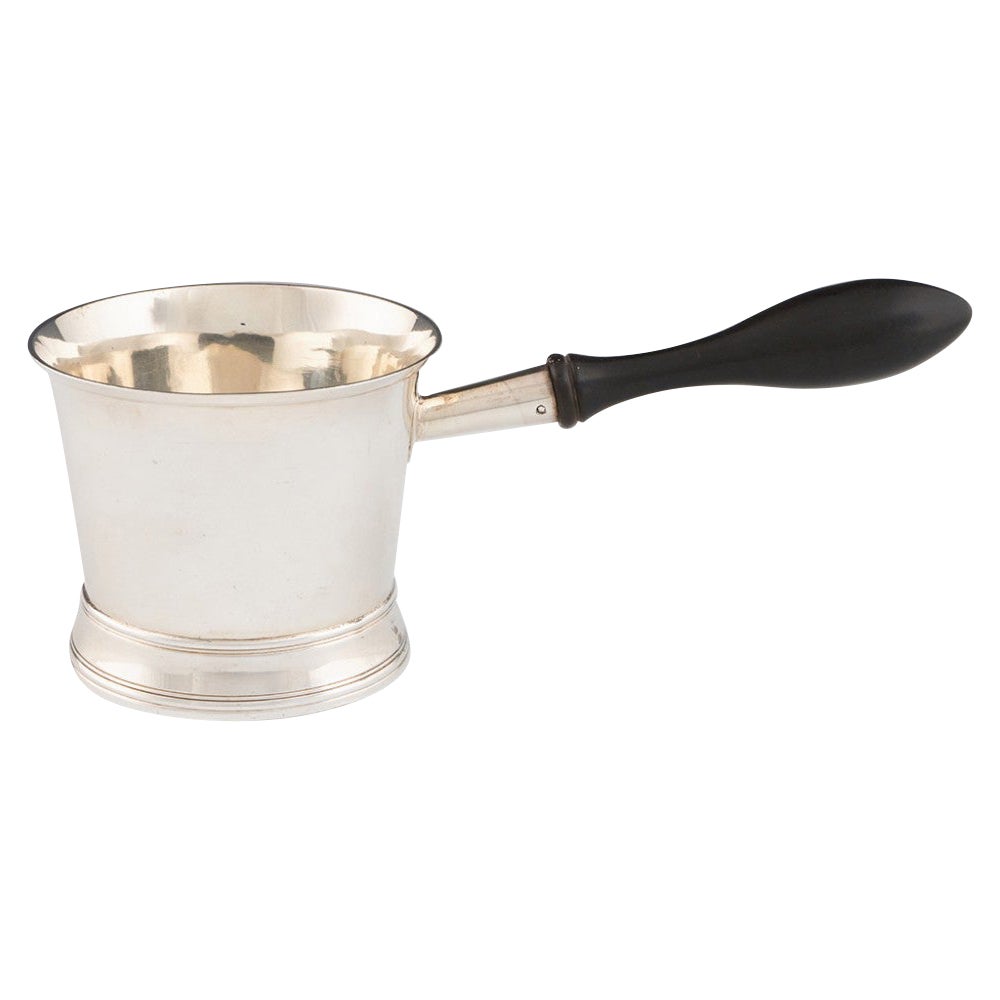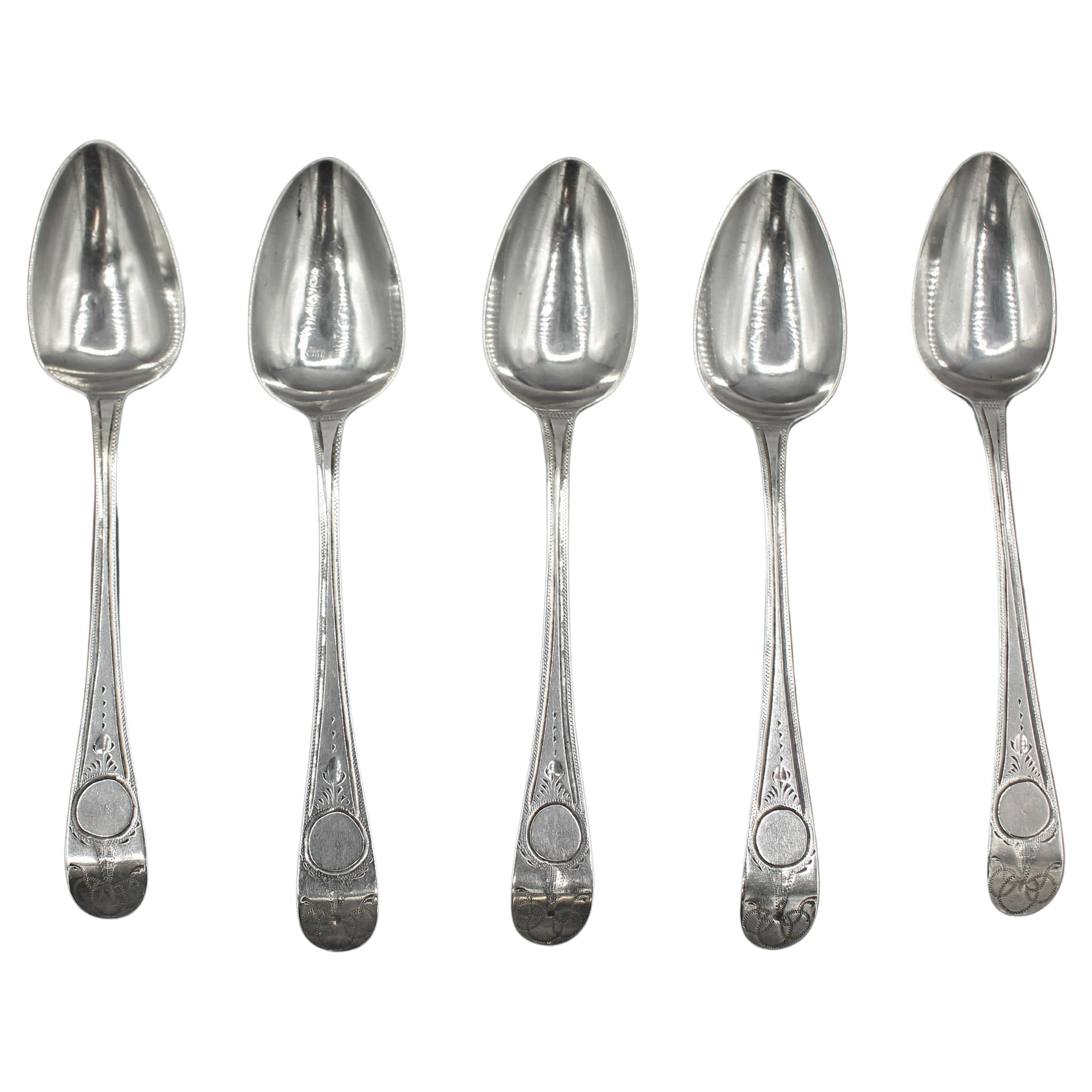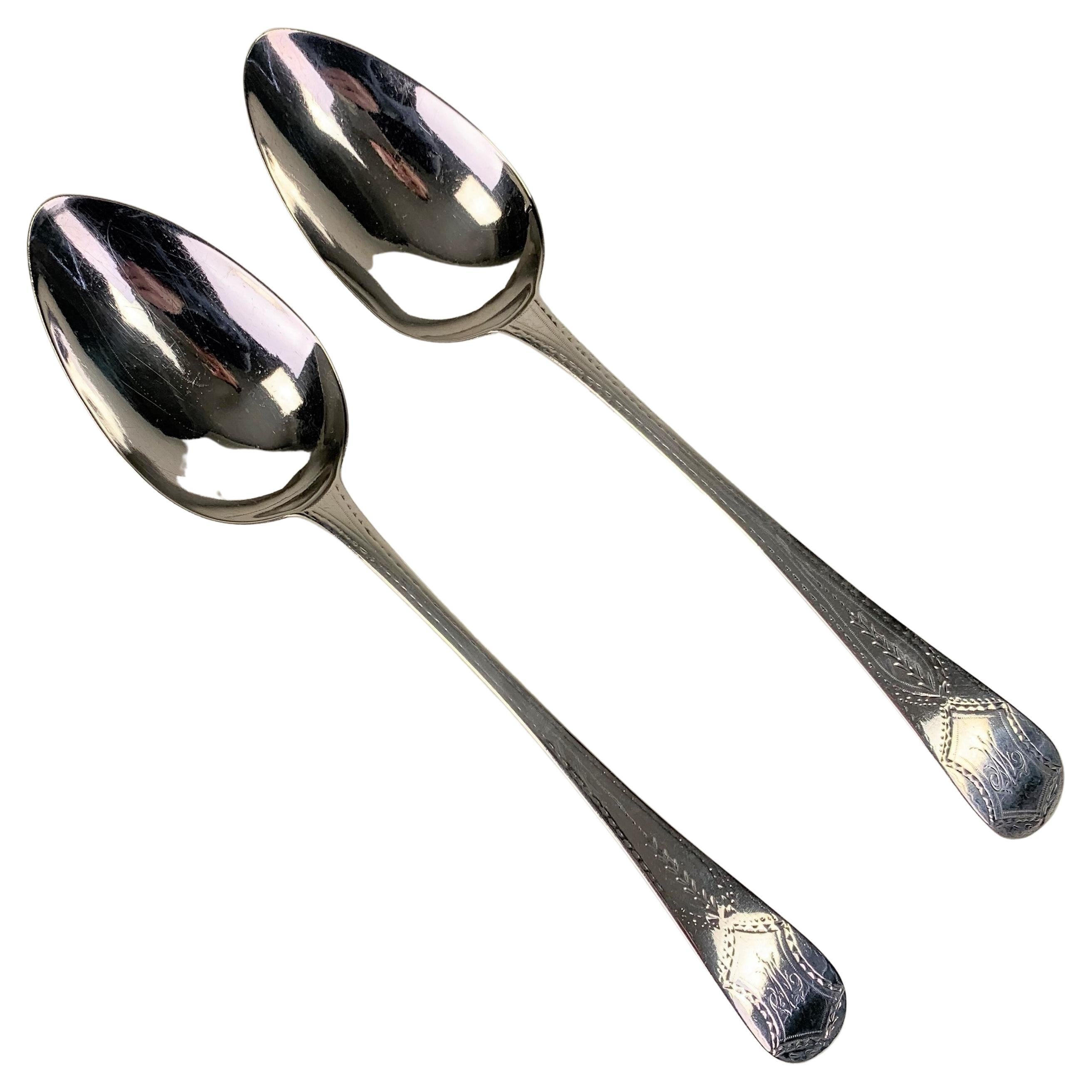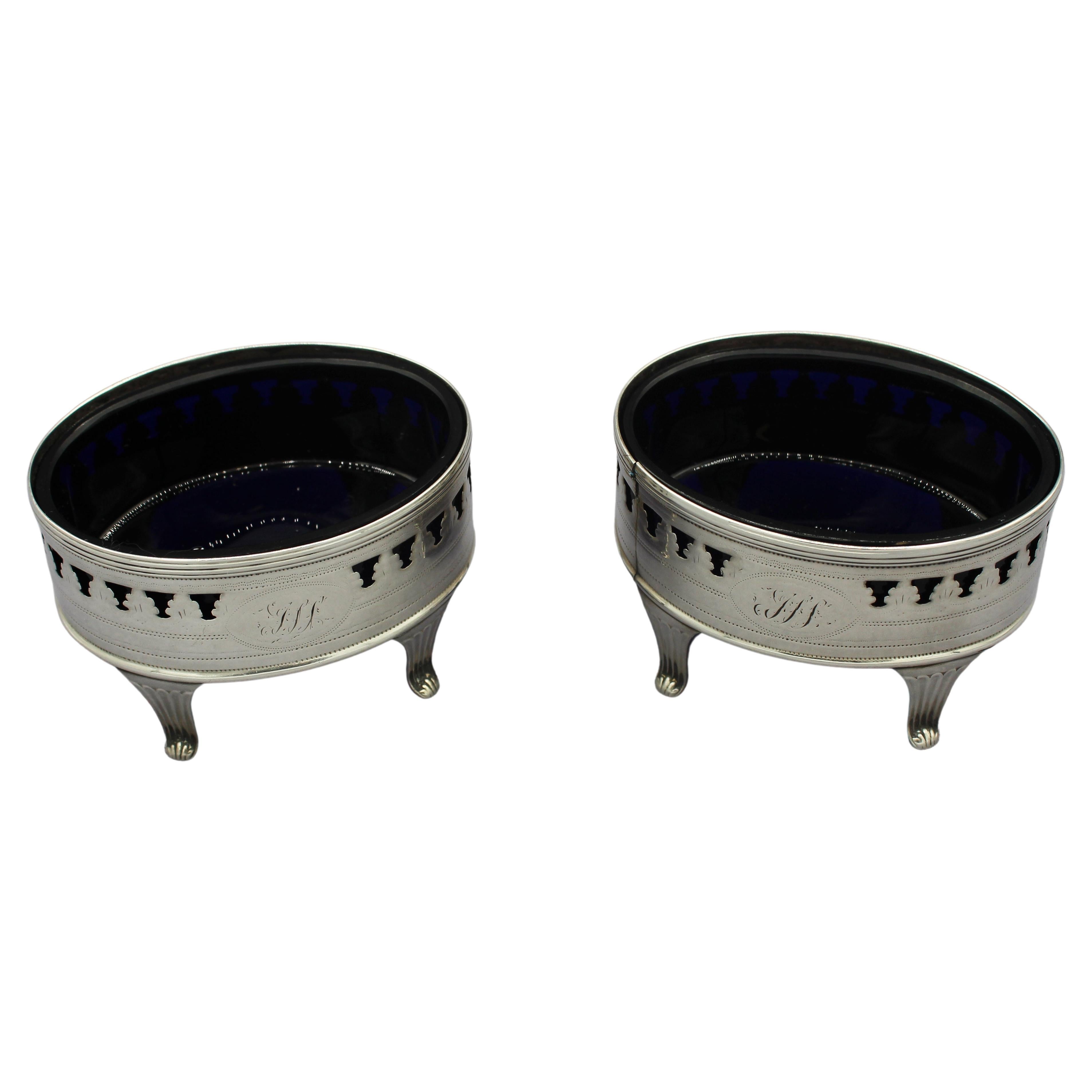Items Similar to George III Silver Teapot Peter & Ann Bateman
Want more images or videos?
Request additional images or videos from the seller
1 of 20
George III Silver Teapot Peter & Ann Bateman
About the Item
Hallmarks Dated 1796
From our Silver collection, we are delighted to offer this original George III Silver Teapot by Peter & Ann Bateman. The Teapot of elongated oval form with a straight rising spout and looped wood handle. The top of the teapot with a convex lid slightly bowed surmounted with a pineapple finial. The exterior of the Teapot is decorated with a banding of engraved roundels with floral patterns to the centre. Each side has a central circular cartouche with a central vacant initial plaque. The Teapot dates to the late 18th century Georgian period during the reign of George III and is hallmarked Sterling Silver, London by Peter & Ann Bateman and dated 1796.
Peter & Ann Bateman were the daughter-in-law (widow of Jonathan) and son of Hester Bateman, regarded as the most well known of all English lady silversmiths of the 18th century whose work today highly sought after. Hester married the goldsmith John Bateman in 1732, and together they worked a small silversmith business. Following the death of her husband in 1760 she successfully ran her family business for thirty years and was succeeded in turn by her sons, grandson and great-grandson and the Bateman family silversmithing company lasted until the middle of the nineteenth century.
Hester was known to have had at least five children, Jonathan, Peter, most likely John (recorded as a watch and clockmaker), Letitia (who married Richard Clarke), and Ann. Only Peter, Letitia, and Ann were still living at the time of Hester’s death. Hester registered her mark at Goldsmith’s Hall ‘April 16, 1761, as Hester Bateman in Bunnhill Row and this mark was used until 1790. The first mark contained a scripted lettered initials HB. That same year a registered mark of her sons Peter Bateman and John Bateman was entered however this partnership was short as Jonathan who married Ann Downlinff died in 1791. There mark contained the initials PB JB in simple plain form with a square. Peter Bateman and now Ann Bateman (widow to Jonathan) registered a mark Peter and Ann Bateman in 1791 which contained PB AB. Hester Bateman died in a few years later in 1794 and the business continued to thrive in the family. In 1800 registered mark Peter, Ann and William Bateman was introduced as William the son of Johnathan and Ann joined his Mother and Uncle in partnership, their mark contained the initials PB AB and WB stacked on top of each other in a square. When Ann retired in 1805 the registered mark Peter and William was entered as PB WB. From 1815 to 1840 William Bateman was registered alone.
Sterling Silver is an alloy composed by weight of 92.5% silver and 7.5% other metals, usually copper. The sterling silver standard has a minimum millesimal fineness (parts per thousand) of 925.
Measurements (centimetres) 18cm High x 27.5cm Long x 9.5cm Wide
Weight 432 grams
- Creator:Peter and Ann Bateman (Metalworker)
- Dimensions:Height: 7.1 in (18.04 cm)Width: 10.8 in (27.44 cm)Depth: 3.74 in (9.5 cm)
- Style:George III (Of the Period)
- Materials and Techniques:
- Place of Origin:
- Period:
- Date of Manufacture:1796
- Condition:Wear consistent with age and use. Minor cracking to the finial.
- Seller Location:Newark, GB
- Reference Number:
About the Seller
5.0
Vetted Seller
These experienced sellers undergo a comprehensive evaluation by our team of in-house experts.
Established in 2019
1stDibs seller since 2022
18 sales on 1stDibs
Typical response time: 3 hours
- ShippingRetrieving quote...Ships From: Newark, United Kingdom
- Return PolicyA return for this item may be initiated within 14 days of delivery.
More From This SellerView All
- George III Erotic Silver Vinaigrette by Joseph Ash IBy Joseph Ash ILocated in Newark, EnglandFine and very rare erotic silver vinaigrette. The vinaigrette of circular form with removable lid revealing the grill containing the sponge underneath. T...Category
Antique Early 1800s British George III Sterling Silver
MaterialsSilver
- Silver Horse Cigarette Case AspreyBy Asprey International LimitedLocated in Newark, EnglandHallmarked Asprey, London The case of flat rectangular form with a splayed lid and base featuring a neat engine turned pattern throughout. The lid with a high quality engraved horse...Category
Mid-20th Century English Mid-Century Modern Sterling Silver
MaterialsSilver, Sterling Silver
- German Silver Gilt Minaudière Louis KuppenheimBy Louis KuppenheimLocated in Newark, EnglandThe minaudière of rectangular form with curved corners features a repousse monkey which humorously goes through the case with the front side of the monkey on the cover and the rear side of the monkey on the back. The exterior of the case is gilded Silver with cabochon Sapphires and a top carry loop. To the left of the top a second loop contains the original pencil which pulls out for taking notes upon the ivorine notepad within. The interior of the case features several compartments which open via the Sapphire tabs, the left side contains two smaller compartments while the right side features a bevel edged mirror with an ivorine notepad to the reverse and a spring loaded tab to the compartment. The case is hallmarked in several locations with the London ‘omega’ import mark (1906-1998), the import Silversmiths mark Gresham Barber & Co and is dated 1907. Although the minaudière does not bear the original makers hallmark we firmly attribute the case to Louis Kuppenheim a renowned German Silversmith who made designs matching this minaudière. Louis Kuppenheim (1824-1889)was founded in 1854 together with Heinrich Witzemann they were located in Pforzheim, southwestern Germany and is known as the gateway to the Black Forest. In 1857 Kuppenheim moved forward as a solo business without his partner and moved to Durlacher Straße 1, Old Town street in Pforzheim. Upon the death of Louis Kuppenheim in 1889 3 of his 6 children (Albert, Hugo and Moritz) took over running the company and in 1900 at the Universal Exhibition in Paris the firm won a gold medal for a paper knife. In the same year the company opened the first store in the Rue de Richelieu 67 in Paris. In the 1900s Hans Christiansen designed some silver parts and pieces of jewellery, which were made by the Manufacture Kuppenheim. Christiansen was an important Art Nouveau painter and a member of the Darmstadt artists’ colony. In 1906 Albert, Hugo and Moritz convert the inherited jewellery factory into a modern gold and silverware fabrication and one year later relocated to 69 Durocher Street. Over the next 30 years the company expanded their business with mechanical workshops for gold and silver along with more machinery along with the death of Albert Kuppenheim and Ludwig (another son of Louis) taking over the company. After the war broke out in 1939 the company went into liquidation ending its 82 year history. During the heyday of the company over 200 people were employed by Louis Kuppenheim making it one of the most important employers in the jewellery city of Pforzheim. In the more than eighty years of production some 100,000 pieces left the company. Kuppenheim made many items in small series, for example boxes and minaudières (women’s fashion accessory, generally considered a jewellery piece, intended to substitute for an evening bag. A case with compartments, it allows storage for several items in a small space, such as a makeup compact, lipstick, watch, reading glasses, or keys) and compacts and cigarette cases...Category
Antique Early 1900s German Art Nouveau Sterling Silver
MaterialsGold Plate, Silver
- Silver and Enamel Cigarette Case ViennaLocated in Newark, EnglandHallmarked From our Silver collection, we are delighted to offer this Art Nouveau Silver and Enamel Cigarette Case from Vienna, Austria. The Silver and Enamel Cigarette Case of stunning Art Nouveau design with a central enamel scene depicting the legend of St. Hubert, Patron Saint of hunters with the divine deer. The scene features St. Hubert in the foreground dressed much like the later Robin Hood with feathered cap carrying a cross bow. In the background the divine deer stands on a river bank with long antlers portraying a crucifix between them amongst foliage and trees. The Scene flanked by Art Nouveau design upon a Silver case with push button thumb tab. The interior of the Cigarette Case is finished in silver-gilt with an inscription to the left hand side reading Mr et Mdme. Dr Groedel Hietzing 20/VII 1900. (20/07/1900). The Silver and Enamel Cigarette Case is hallmarked twice on the thumb tab, once below the ‘1900’ and twice on the right hand side of the inner case. The last hallmarks feature an illegible makers mark however it is clear that the hallmarks show the hexagonal Dianakopf (Diana’s head) mark showing the silver is .900 fineness and dated to between 1872-1922 inline with the inscription date of 1900. Dianakopf (Diana’s Head) was first used in 1867 the cartouche shape and number within indicate the silver fineness. Beginning in 1872, a letter was added to indicate city of assay. The hallmark comes in varied shapes depending on the year and fineness. Hietzing is the 13th municipal District of Vienna. It is located west of the central districts, west of Meidling. Hietzing is a heavily populated urban area with many residential buildings but also contains large areas of the Vienna Woods, along with Schönbrunn Palace. St. Hubert The legend of St. Hubert holds that on a Good Friday morning, while the faithful were in church, Hubert was hunting in the forest. As he pursued a magnificent stag or hart, the animal turned and Hubert was astounded to see a crucifix floating between its antlers. He heard a voice saying: “Hubert unless thou turnest to the Lord and leadest a holy life, thou shalt quickly go down into Hell.” Hubert dismounted and prostrated himself, and after asking “Lord, what wouldst thou have me do?” is told, “Go and seek Lambert, and he will instruct you.” The story of the stag first appears in one of the later legendary hagiographies (Bibliotheca hagiographic Latina, nos. 3994–4002) and has been appropriated from the legend of Saint Eustace...Category
Antique Early 1900s Austrian Art Nouveau Sterling Silver
MaterialsSilver, Enamel
- Chinese Export Silver Basket Wang HingBy Wang Hing & Co.Located in Newark, EnglandFine Chinese silver basket (bon-bon dish/bridal basket) circa 1900. The presentation basket of circular form expertly crafted with spigs of blossoming flowers to the outer boarder ho...Category
Antique Early 1900s Chinese Qing Sterling Silver
MaterialsSilver
- Dutch Military Silver Snipe Sugar SifterLocated in Newark, EnglandThe Silver sifter in the form of a Snipe bird with long pointed bill, short wings and short legs. The Snipe cast in solid silver with multiple hallmark located around the collar, rem...Category
Early 20th Century Dutch Dutch Colonial Sterling Silver
MaterialsSilver, Sterling Silver
You May Also Like
- Silver Brandy Pan Peter and Ann Bateman London 1804By Peter and Ann BatemanLocated in Tunbridge Wells, GBHeading : Sterling silver brandy pan by Peter and Ann Bateman Date : Hallmarked in London 1804 Period : George III Origin : London, England Decoratio...Category
Antique Early 1800s British George III Sterling Silver
MaterialsSilver
- Sterling Silver Cream Jug Creamer by Peter and Ann BatemanBy Peter and Ann BatemanLocated in Jesmond, Newcastle Upon TyneA fine and impressive antique George III English sterling silver helmet shaped creamer made by Peter and Ann Bateman; an addition to our Georgian silver ...Category
Antique 1790s English George III Sterling Silver
MaterialsSterling Silver
- Set of 5 Sterling Silver Coffee Spoons by Peter & Ann BatemanBy Peter and Ann BatemanLocated in Chapel Hill, NCSet of 5 sterling silver coffee spoons by Peter & Ann Bateman, London, 1796. Georgian neoclassical design. Peter was Hester's son & Ann was the widow of her other son Jonathan. Engra...Category
Antique 1790s English Georgian Sterling Silver
MaterialsSterling Silver
- Georgian 'George III' Sterling Silver Helmet-Form Cream Jug/Pitcher, by BatemanBy Peter and Ann BatemanLocated in New York, NYGeorgian (George III), sterling silver, helmet-form cream jug/pitcher on square, pedestal base, London, year-hallmarked for 1795, Peter and Anne Bateman - makers. Measures 5 3/4 inches high (to top of handle) x 4 inches wide (from outer edge of spout to outer edge of handle) x 2 1/4 inches deep at deepest point. Weighs 3.190 troy ounces. Beaded border. Original script...Category
Antique 1790s English George III Sterling Silver
MaterialsSterling Silver
- Pair of Bright Cut Tablespoons by Peter & Ann Bateman, 1792By Peter and Ann BatemanLocated in Folkestone, GBFine pair of bright cut tablespoons by PETER & ANN BATEMAN, London 1792. In excellent condition with almost no sign of ware or damage. 120 grams total. Each spoon 22cms long.Category
Antique 1790s English Georgian Sterling Silver
MaterialsSilver
- 1797 Pair of Sterling Silver Master Salts by Peter & Ann BatemanBy Peter and Ann BatemanLocated in Chapel Hill, NCPair of sterling silver oval master salts by Peter & Ann Bateman, London, 1797. Cobalt glass liners. Elegantly pierced; neoclassical design typical of the Bateman family work. Scroll...Category
Antique Late 18th Century English Neoclassical Sterling Silver
MaterialsSterling Silver





